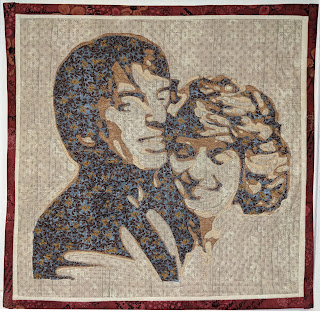I learned a few things that have been very helpful. For instance, the Heat n Bond was leaving it too stiff and left the needle gummed up. I switched to Steam n Seam 2 and I'm so happy with it. It's a peel and stick kind of fusible sheet that you can reposition over and over until you decide to press it. When you press it, it then becomes permanent. I haven't actually ironed it yet, but I did semi-fuse it with my Clover mini craft iron. It isn't completely permanent yet - I just need it to stay put until I stitch it in place. But I really like how lightweight it is.
Speaking of thread, I'm a new convert to Superior Threads. I didn't realize what a difference high quality thread would make. Their MicroQuilter thread is so thin, it's almost invisible, but it's incredibly strong. I can't wait to get to the quilting part of this project!
This is where I am with Leslie and Trevan.
I'm finally done cutting and fusing. Once the teeth, eyelashes, eyebrows and other small outlining details are stitched, I'll share it again and then quilt it, bind it and move onto the next project.
























